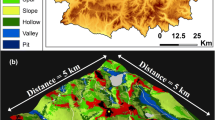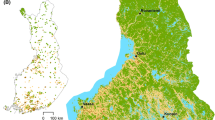Abstract
Information on plant adaptation can be very useful in agrobiodiversity studies. Ecogeographical land characterization (ELC) maps constitute a new tool in this direction with great potential. To assess the usefulness of this approach, an ELC map of Spain was created through multivariate methods. Its performance to characterize plant habitat preferences was compared with existing ecological regions and land cover maps. Collecting sites and seed weight from eight plant species were used to test the ELC map. Categories from each map were assigned to accessions using collecting sites. Chi-square tests were applied to test if category frequency distributions for each species followed a distribution proportional to the relative frequency of categories in each map. The tests found significant differences in the eight species studied. Thus, Bonferroni confidence intervals (BCI) classified categories from maps in preferred, neutral or avoided habitats. Seed weight was used as a proxy for plant adaptation. Comparison between observed and expected ranking of BCI and quartile classes in terms of seed weight means, and GLM and post-hoc tests carried out to test the effect of these classes upon seed weight showed consistently better results for the ELC map. Species results and applications of ecogeographic maps in plant genetic resources conservation are discussed.




Similar content being viewed by others
References
Allard RW (1988) Genetic changes associated with the evolution of adaptedness in cultivated plants and their wild progenitors. J Hered 79:225–238
Allard RW (1996) Genetic basis of the evolution of adaptedness in plants. Euphytica 92:1–11
Bacher J (2000) A probabilistic clustering model for variables of mixed type. Qual Quant 34:223–235
Bailey RG (1983) Delineation of ecosystem regions. Environ Manage 7:365–373
Baker HG (1972) Seed weight in relation to environmental conditions in California. Ecology 53:997–1010
Bhullar NK, Street K, Mackay M, Yahiaoui N, Keller B (2009) Unlocking wheat genetic resources for the molecular identification of previously undescribed functional alleles at the Pm3 resistance locus. Proc Natl Acad Sci USA 106:9519–9524
Bossard M, Feranec J, Otahel J (2000) CORINE land cover technical guide—Addendum 2000. European Environment Agency, Copenhagen
Byers DL (2005) Evolution in heterogeneous environments and the potential of maintenance of genetic variation in traits of adaptive significance. Genetica 123:107–124
Byers CR, Steinhorst RK (1984) Clarification of a technique for analysis of utilization-availability data. J Wildl Manage 48:1050–1053
Casquero PA, Lema M, Santalla M, De Ron AM (2006) Performance of common bean (Phaseolus vulgaris L.) landraces for Spain in the Atlantic and Mediterranean environments. Genet Resour Crop Evol 53:1021–1032
Cavers PB, Steel MG (1984) Patterns of change in seed weight over time on individual plants. Am Nat 124:324–335
Ceballos-Silva A, López-Blanco J (2003) Evaluating biophysical variables to identify suitable areas for oat in Central Mexico: a multi-criteria and GIS approach. Agric Ecosyst Environ 95:371–377
Chiu T, Fang D, Chen J, Wang Y, Jeris C (2001) A robust and scalable clustering algorithm for mixed type attributes in large database environment. In: proceedings of the 7th ACM SIGKDD international conference on knowledge discovery and data mining, San Francisco, pp 263–268
Ferguson ME, Jarvis A, Stalker HT, Williams DE, Guarino L, Valls JFM, Pittman RN, Simpson CE, Bramel PJ (2005) Biogeography of wild Arachis (Leguminosae): distribution and environmental characterisation. Biodivers Conserv 14:1777–1798
Ghamkhar K, Snowball R, Bennett SJ (2007) Ecogeographical studies identify diversity and potential gaps in the largest germplasm collection of bladder clover (Trifolium spumosum L.). Aust J Agric Res 58:728–738
Ghamkhar K, Snowball R, Wintle BJ, Brown AHD (2008) Strategies for developing a core collection of bladder clover (Trifolium spumosum L.) using ecological and agro-morphological data. Aust J Agric Res 59:1103–1112
Greene SL, Hart TC (1999) Implementing a geographic analysis in germplasm conservation. In: Greene SL, Guarino L (eds) Linking genetic resources and geography: emerging strategies for conserving crop biodiversity. American Society of Agonomy and Crop Science Society of America, Madison, Wisconsin, pp 25–38
Hijmans RJ, Guarino L, Cruz M, Rojas E (2001) Computer tools for spatial analysis of plant genetic resources data: 1. DIVA-GIS. Plant Genet Resour Newsl 127:15–19
Hijmans RJ, Cameron SE, Parra JL, Jones PG, Jarvis A (2005) Very high resolution interpolated climate surfaces for global land areas. Int J Climatol 25:1965–1978
Hossell JE, Riding AE, Brown I (2003) The creation and characterisation of a bioclimatic classification for Britain and Ireland. J Nat Conserv 11:5–13
Instituto Geográfico Nacional (1992) Atlas nacional de España, sección II, grupo 7, edafología. Instituto Geográfico Nacional, Madrid
Irland LC (1997) Maine’s forest vegetation regions: selected maps 1858–1993. Northeast Nat 4:241–260
Jarvis A, Yeaman S, Guarino L, Tohme J (2006) The role of geographic analysis in locating, understanding, and using plant genetic diversity. Methods Enzymol 395:279–298
Klijn F, de Waal RW, Oude Voshaar JH (1995) Ecoregions and ecodistricts: ecological regionalizations for the Netherlands’ environmental policy. Environ Manage 19:797–813
Korona R (1996) Adaptation to structurally different environments. Proc Royal Soc Biol Sci 263:1665–1669
Lázaro A, Ruiz M, de la Rosa L, Martín I (2001) Relationships between agro/morphological characters and climatic parameters in Spanish landraces of lentil (Lens culinaris Medik.). Genet Resour Crop Evol 48:239–249
Lobo Burle M, Torres Cordeiro CM, Fonseca JR, Palhares de Melo M, Neves Alves R, Abadie T (2003) Characterization of germplasm according to environmental conditions at the collecting site using GIS—two case studies from Brazil. Plant Genet Resour Newsl 135:1–11
Lobo JM, Castro I, Moreno JC (2001) Spatial and environmental determinants of vascular plant species richness distributions in the Iberian Peninsula and Balearic Islands. Biol J Linn Soc 73:233–253
Marchand DE (1973) Edaphic control of plant distribution in the White Mountains, eastern California. Ecology 54:233–250
Martin de Agar P, de Pablo CL, Pineda FD (1995) Mapping the ecological structure of a territory: a case study in Madrid (Central Spain). Environ Manage 19:345–357
McKenney DW, Pedlar JH, Lawrence K, Campbell K, Hutchinson MF (2007) Beyond traditional hardiness zones: using climate envelopes to map plant range limits. Bioscience 57:929–937
Michailidou C, Maheras P, Arseni-Papadimititriou A, Kolyva-Machera F, Anagnostopoulou C (2009) A study of weather types at Athens and Thessaloniki and their relationship to circulation types for the cold-wet period, part I: two-step cluster analysis. Theor Appl Climatol 97:163–177
Monserud RA, Leemans R (1992) Comparing global vegetation maps with the Kappa statistic. Ecol Model 62:275–293
Nichols WF, Killingbeck KT, August PV (1998) The influence of geomorphological heterogeneity on biodiversity: II. A landscape perspective. Conserv Biol 12:371–379
Ozenda P, Borel JL (2000) An ecological map of Europe: why and how? CR Acad Sci-Ser III-Sci Vie 323:983–994
Painho M, Farral H, Barata F (1996) Digital map of European ecological regions (DMEER). Its concept and elaboration. In: Rumor M, McMillan R, Ottens HFL (eds) Geographical information: from research to application through cooperation. IOS Press, Amsterdam, pp 437–446
Parra-Quijano M, Draper D, Torres E, Iriondo JM (2008) Ecogeographical representativeness in crop wild relative ex situ collections. In: Maxted N, Ford-Lloyd BV, Kell SP, Iriondo JM, Dulloo ME, Turok J (eds) Crop wild relative conservation and use. CAB International, Wallingford, pp 249–273
Peeters JP, Wilkes HG, Galwey NW (1990) The use of ecogeographical data in the exploitation of variation from gene banks. Theor Appl Genet 80:110–112
Pérez de la Vega M (1996) Plant genetic adaptedness to climatic and edaphic environment. Euphytica 92:27–38
Prentice IC, Cramer W, Harrison SP, Leemans R, Monserud RA, Solomon AM (1992) A global biome model based on plant physiology and dominance, soil properties and climate. J Biogeogr 19:117–134
Rabus B, Eineder M, Roth A, Bamler R (2003) The shuttle radar topography mission—a new class of digital elevation models acquired by spaceborne radar. ISPRS-J Photogramm Remote Sens 57:241–262
Rai M, Srivastava KN (2001) Role of transgenic plants in abiotic stress management. J New Seeds 3:43–69
Rao VR, Hodgkin T (2002) Genetic diversity and conservation and utilization of plant genetic resources. Plant Cell Tissues Organ Cult 68:1–19
Silvertown J (1989) The paradox of seed size and adaptation. Trends Ecol Evol 4:24–26
SPSS (2003) SPSS Base 12.0 user’s guide. SPSS, Chicago
Vinocur B, Altman A (2005) Recent advances in engineering plant tolerance to abiotic stress: achievements and limitations. Curr Opin Biotechnol 16:123–132
Vogel KP, Schmer MR, Mitchell RB (2005) Plant adaptation regions: ecological and climatic classification of plant materials. Rangel Ecol Manag 58:315–318
Wang G, Zhou G, Yang L, Li Z (2003) Distribution, species diversity and life-form spectra of plant communities along an altitudinal gradient in the northern slopes of Qilianshan Mountains, Gansu, China. Plant Ecol 165:169–181
Williams CL, Hargrove WW, Liebman M, James DE (2008) Agro-ecoregionalization of Iowa using multivariate geographical clustering. Agric Ecosyst Environ 123:161–174
Acknowledgments
We would like to thank the personnel at CRF-INIA, in particular to Lucía de la Rosa and Edurne Aguiriano. We are also grateful to Miguel Ibañez for his statistical advice and Lori J. De Hond for linguistic assistance.
Author information
Authors and Affiliations
Corresponding author
Electronic supplementary material
Below is the link to the electronic supplementary material.
Rights and permissions
About this article
Cite this article
Parra-Quijano, M., Iriondo, J.M. & Torres, E. Ecogeographical land characterization maps as a tool for assessing plant adaptation and their implications in agrobiodiversity studies. Genet Resour Crop Evol 59, 205–217 (2012). https://doi.org/10.1007/s10722-011-9676-7
Received:
Accepted:
Published:
Issue Date:
DOI: https://doi.org/10.1007/s10722-011-9676-7




